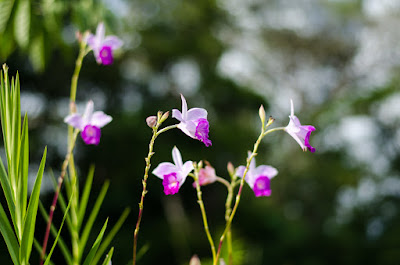Arundina graminifolia is native to the tropical and subtropical Asia from the Himalayas to Tahiti. It occurs naturally in lowland secondary forests, right up to higher altitudes in the tropical montane forests, at elevations of sea level to 1200 meters. Its natural habitats include open areas, grassland, mountains and rock places by streams.
Arundina graminifolia also called as The Bamboo Orchid, The Grass-Like Leaf Arundina, Arundina affinis, Arundina bambusifolia, Arundina cantleyi, Arundina celebica, Arundina chinensis, Arundina densa, Arundina densiflora, Arundina graminifolia var. revolute, Arundina maculata, Arundina meyenii, Arundina minor, Arundina philippi, Arundina pulchella, Arundina pulchra, Arundina revoluta, Arundina sanderiana, Arundina speciosa, Arundina speciosa var. sarasinorum, Arundina stenopetala, Arundina subsessilis, Arundina tahitensis, Bletia graminifolia, Cymbidium bambusifolium, Cymbidium meyenii, Cymbidium speciosum, Donacopsis laotica, Limodorum graminifolium, Ophrys arundinacea, is a species of the genus Arundina. This species was described by Bénédict Pierre Georges Hochreutiner in 1910.
IDENTIFY ARUNDINA GRAMINIFOLIA ORCHID PLANT
Arundina graminifolia is native to the tropical and subtropical Asia from the Himalayas to Tahiti. It occurs naturally in lowland secondary forests, right up to higher altitudes in the tropical montane forests, at elevations of sea level to 1200 meters. Its natural habitats include open areas, grassland, mountains and rock places by streams.
The Grass-Like Leaf Arundina is a giant sized, hot to cool growing, polypodial, terrestrial orchid, clumping herb consisting of leafy, erect stems joined at the base, up to 2.5 m tall with alternate grass-like, 9-19 cm long, 0.8 to 1.5 cm wide leaves.
The Bamboo Orchid blooms through out the year on a terminal, 8 cm long, simple or branched, scapose, bracteate inflorescence that carries 2 to 6, fragrant flowers, one at a time, that are short-lasting yet successive so the bloom time is extended. The flowers are large, .5-8 cm in diameter. Its three sepals and two lateral petals are white to pink. The third petal is modified to a bright rosy purple lip with a central yellow patch.
ARUNDINA GRAMINIFOLIA ORCHID PLANT CARE AND CULTURE
Cultural information should only be used as a guide, and should be to be adapted to suit you. Your physical location; where you grow your plants, how much time you have to devote to their care, and many other factors, will need to be taken into account. Only then can you decide on the cultural methods that best suit you and your plants.
Light:
In nature, Arundina graminifolia are commonly grow in direct sunlight, but 20000-30000 lux is ideal. Don't put it in direct sunlight as the leaves can burn due to the higher humidity and moisture levels. You can diffuse the level of sunlight your orchid gets by placing it slightly away from windows. If it doesn't bloom, try increasing the lighting.
Temperature:
The Bamboo Orchid comes from tropical regions, so it is best results growing them at warm temperatures, 24-29°C during the day, 16-21°C at night with a diurnal range from 6-8°C. During the winter months, you can keep your orchid in slightly lower daytime temperatures around 16°C with nighttime temperatures around 10°C.
Humidity:
The Grass-Like Leaf Arundina like good humidity, perhaps 70%, though this isn't critical. If the humidity is low, the plant should be misted regularly, especially if it has any keikis.
Substrate, growing media and repotting:
Arundina graminifolia grows well mounted on bark, in a pot, or in a hanging basket with a mix substrate which consist of coco peat moss or coconut fibre (coir), vermiculite or perlite, compost and other ingredients. A lightweight soil needs to provide good drainage, hold moisture, and give roots room to grow.
The plant should repot every two to three years, and it's best to done it in the springtime. When you've removed it from the pot, cut away any dead or dying roots. You can repot it back into the original container with fresh compost mixed around its roots. Water it sparingly for six weeks to help it reestablish itself, and don't bury the roots completely as they do better when they're semi-exposed to the air and sunlight.
Watering:
Water sparingly until the plant have sign of active grow (new buds). After that, you can start to water it weekly and spritz it between watering to keep it moist. The plant should be watered as they approach dryness; don't let them dry out too thoroughly. If you grow them outdoors, either if you live in a warm climate or if you just brought it outdoors for the summer, rainfall might water it often enough in some areas; but if it's starting to dry out water it thoroughly. If you grow orchids indoors, these plants are often too big to take to the sink; the easiest way to water will often be to dunk the pot in a bucket, then pull it out. In winter, the amount of water can somewhat reduced until spring.
Fertilizer:
Feed this orchid once every two weeks with a quarter of a packet of high-nitrogen fertilizer that you have diluted to half strength. In winter, fertilization can be reduced or completely eliminated.

















COMMENTS